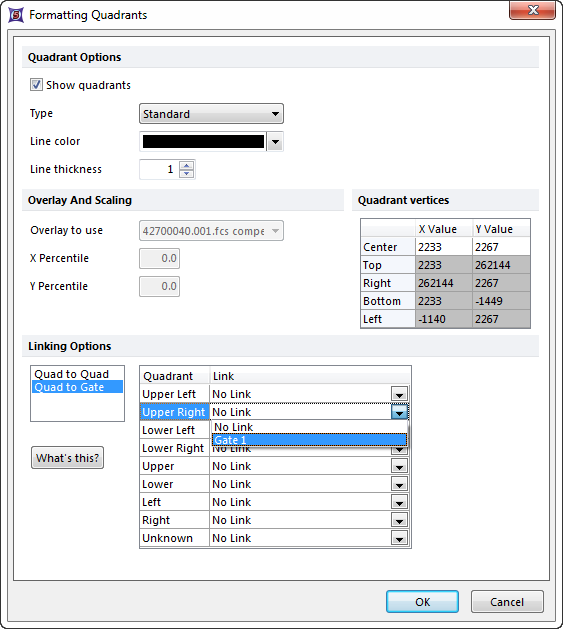Quadrants
The Quadrants category allows you to manipulate the quadrants on a 2D plot. Quadrants can also be created and their positions adjusted directly from the plot.
You can edit quadrants in one of two ways:
| • | Select the 2D plot and use the Format→2D Options→Quadrants command. |
| • | Right-click on the 2D plot, select Format from the pop-up menu, and choose the Quads category (Figure 8.73). |

Figure 8.74 Formatting Quadrants dialog
The options on the left side of the dialog are explained in the table below.
Option |
Explanation |
||||||||||
|---|---|---|---|---|---|---|---|---|---|---|---|
Show quadrants |
Choose whether to display the quadrants on the plot. |
||||||||||
Type |
The type can be one of the following:
|
||||||||||
Line color and thickness |
The color and thickness that the quadrant lines will be drawn in. |
||||||||||
Quadrant vertices |
The precise coordinates of the quadrant vertices. These can be entered manually for precise control over quadrant positioning. Note: Quadrants are stored in 256x256 resolution; therefore, not all possible values for quad vertices will be available. |
||||||||||
Overlay to use |
Which overlay to use when calculating the percentiles for the X Percentile and Y Percentile quadrant types. |
||||||||||
X Percentile |
Which percentile to use for the X Percentile and Both Percentile quadrant types. |
||||||||||
Y Percentile |
Which percentile to use for the Y Percentile and Both Percentile quadrant types. |
Quadrants can either be linked to other quadrants or to gates. You can change the current links from the Linking Options area of the dialog.
To change the quadrant to quadrant link, select Quad to Quad and choose the plot you want to link to the current plot. The quadrants on the current plot will become a "slave" to the quadrants on the linked plot, i.e., when the properties of the quadrants on the linked plot change, the quadrants on the current plot will also change. For example, by linking plots to an isotype control plot, the quadrants in the linked plots will automatically adjust if the isotype control quadrants are adjusted.
If quadrants on the plots have been converted and linked to gates, these links can be changed or broken in the Quad to Gate dialog. The dialog will appear similar to Figure 8.74.

Figure 8.75 Linking Quad to Gate
In order to change or break the link, select the down arrow to the right of the drop-down list. Select No Link to break the link between the quadrant and the region. Below the No Link item will be a list of gates previously linked to other quadrants on this plot, and now available for linkage to the selected quadrant. A gate can only be linked to one quadrant in a layout. If the desired gate does not appear in the drop-down list, it is already linked to another quad on the current plot or is not derived from these quadrants at all.
The What's this? button provides useful information on linking options.
